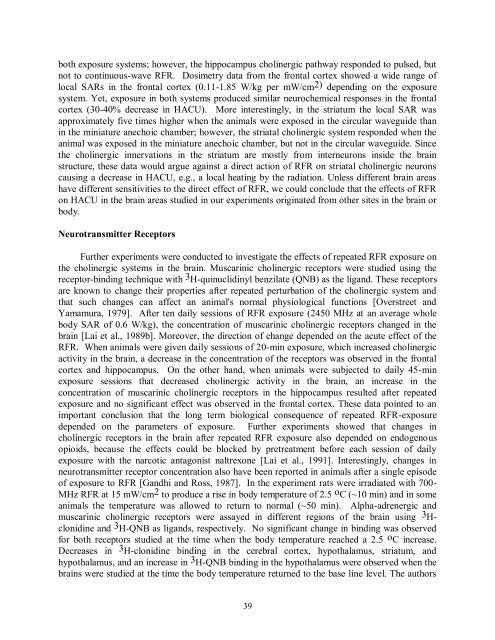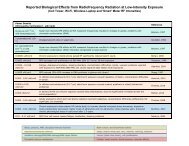Evidence for Effects on Neurology and Behavior - BioInitiative Report
Evidence for Effects on Neurology and Behavior - BioInitiative Report
Evidence for Effects on Neurology and Behavior - BioInitiative Report
You also want an ePaper? Increase the reach of your titles
YUMPU automatically turns print PDFs into web optimized ePapers that Google loves.
oth exposure systems; however, the hippocampus cholinergic pathway resp<strong>on</strong>ded to pulsed, but<br />
not to c<strong>on</strong>tinuous-wave RFR. Dosimetry data from the fr<strong>on</strong>tal cortex showed a wide range of<br />
local SARs in the fr<strong>on</strong>tal cortex (0.11-1.85 W/kg per mW/cm 2) depending <strong>on</strong> the exposure<br />
system. Yet, exposure in both systems produced similar neurochemical resp<strong>on</strong>ses in the fr<strong>on</strong>tal<br />
cortex (30-40% decrease in HACU). More interestingly, in the striatum the local SAR was<br />
approximately five times higher when the animals were exposed in the circular waveguide than<br />
in the miniature anechoic chamber; however, the striatal cholinergic system resp<strong>on</strong>ded when the<br />
animal was exposed in the miniature anechoic chamber, but not in the circular waveguide. Since<br />
the cholinergic innervati<strong>on</strong>s in the striatum are mostly from interneur<strong>on</strong>s inside the brain<br />
structure, these data would argue against a direct acti<strong>on</strong> of RFR <strong>on</strong> striatal cholinergic neur<strong>on</strong>s<br />
causing a decrease in HACU, e.g., a local heating by the radiati<strong>on</strong>. Unless different brain areas<br />
have different sensitivities to the direct effect of RFR, we could c<strong>on</strong>clude that the effects of RFR<br />
<strong>on</strong> HACU in the brain areas studied in our experiments originated from other sites in the brain or<br />
body.<br />
Neurotransmitter Receptors<br />
Further experiments were c<strong>on</strong>ducted to investigate the effects of repeated RFR exposure <strong>on</strong><br />
the cholinergic systems in the brain. Muscarinic cholinergic receptors were studied using the<br />
receptor-binding technique with 3 H-quinuclidinyl benzilate (QNB) as the lig<strong>and</strong>. These receptors<br />
are known to change their properties after repeated perturbati<strong>on</strong> of the cholinergic system <strong>and</strong><br />
that such changes can affect an animal's normal physiological functi<strong>on</strong>s [Overstreet <strong>and</strong><br />
Yamamura, 1979]. After ten daily sessi<strong>on</strong>s of RFR exposure (2450 MHz at an average whole<br />
body SAR of 0.6 W/kg), the c<strong>on</strong>centrati<strong>on</strong> of muscarinic cholinergic receptors changed in the<br />
brain [Lai et al., 1989b]. Moreover, the directi<strong>on</strong> of change depended <strong>on</strong> the acute effect of the<br />
RFR. When animals were given daily sessi<strong>on</strong>s of 20-min exposure, which increased cholinergic<br />
activity in the brain, a decrease in the c<strong>on</strong>centrati<strong>on</strong> of the receptors was observed in the fr<strong>on</strong>tal<br />
cortex <strong>and</strong> hippocampus. On the other h<strong>and</strong>, when animals were subjected to daily 45-min<br />
exposure sessi<strong>on</strong>s that decreased cholinergic activity in the brain, an increase in the<br />
c<strong>on</strong>centrati<strong>on</strong> of muscarinic cholinergic receptors in the hippocampus resulted after repeated<br />
exposure <strong>and</strong> no significant effect was observed in the fr<strong>on</strong>tal cortex. These data pointed to an<br />
important c<strong>on</strong>clusi<strong>on</strong> that the l<strong>on</strong>g term biological c<strong>on</strong>sequence of repeated RFR-exposure<br />
depended <strong>on</strong> the parameters of exposure. Further experiments showed that changes in<br />
cholinergic receptors in the brain after repeated RFR exposure also depended <strong>on</strong> endogenous<br />
opioids, because the effects could be blocked by pretreatment be<str<strong>on</strong>g>for</str<strong>on</strong>g>e each sessi<strong>on</strong> of daily<br />
exposure with the narcotic antag<strong>on</strong>ist naltrex<strong>on</strong>e [Lai et al., 1991]. Interestingly, changes in<br />
neurotransmitter receptor c<strong>on</strong>centrati<strong>on</strong> also have been reported in animals after a single episode<br />
of exposure to RFR [G<strong>and</strong>hi <strong>and</strong> Ross, 1987]. In the experiment rats were irradiated with 700-<br />
MHz RFR at 15 mW/cm 2 to produce a rise in body temperature of 2.5 o C (~10 min) <strong>and</strong> in some<br />
animals the temperature was allowed to return to normal (~50 min). Alpha-adrenergic <strong>and</strong><br />
muscarinic cholinergic receptors were assayed in different regi<strong>on</strong>s of the brain using 3 H-<br />
cl<strong>on</strong>idine <strong>and</strong> 3 H-QNB as lig<strong>and</strong>s, respectively. No significant change in binding was observed<br />
<str<strong>on</strong>g>for</str<strong>on</strong>g> both receptors studied at the time when the body temperature reached a 2.5 o C increase.<br />
Decreases in 3 H-cl<strong>on</strong>idine binding in the cerebral cortex, hypothalamus, striatum, <strong>and</strong><br />
hypothalamus, <strong>and</strong> an increase in 3 H-QNB binding in the hypothalamus were observed when the<br />
brains were studied at the time the body temperature returned to the base line level. The authors<br />
39



